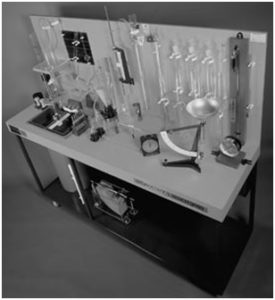FM-HB 5 FLUID PROPERTIES AND HYDROSTATIC BENCH
Description
The Properties of Fluids and Hydrostatics Bench is designed to demonstrate the properties of fluids and their behaviour under hydrostatic conditions (fluid at rest).This allows students to develop an understanding and knowledge of a wide range of fundamental principles and techniques, before studying fluids in motion. The equipment is mounted on a steel-framed bench fitted with castors. A variety of measuring devices is incorporated, either fastened to the back of the bench or freestanding.
Water is stored in a polythene tank situated on the lower shelf of the bench. The water can be transferred by two positive displacement hand pumps either to an elevated open storage tank connected to a number of glass tubes for free surface studies, or to a plastic sink recessed into the working surface so that bench top experiments may be conducted without spillage. All excess water is returned to the storage tank via the sink drain.
Experiments
- Universal hydrometer and hydrometer jars
- Falling sphere viscometers
- Free surface tubes
- Hook and point gauge
- Mercury barometer (Mercury not supplied)
- Bourdon gauge
- u-tube manometers
- Deadweight pressure gauge & weights
- Hydrostatic pressure apparatus
- Pascal’s apparatus
- Parallel plate capillary apparatus
- Capillary tube apparatus
- Lever balance with displacement vessel, bucket & cylinder
- metacentric height apparatus
- Measuring cylinder
- Thermometer
- Air pump
- 600ml beaker
- Stop clock

Instructional Capabilities
Understanding the properties of fluids:
- determining the density, specific gravity and viscosity of different liquids
- observing the effects of capillarity
Understanding the effects of static pressure:
- demonstrating that the free surface of a static liquid is horizontal
- studying the effect of flow on a free surface
- measuring changes in liquid level
- studying the relationship between intensity of liquid pressure and depths
- determining the position of the centre of pressure on a plane surface
Studying the operation and application of pressure gauges and manometers:
- using a direct reading Mercury barometer (Mercury not supplied)
- Measuring air and water pressure using manometers
- comparing results obtained from various devices
- calibrating a Bourdon-type pressure gauge using a dead weight pressure gauge calibrator
Investigating the buoyancy force and stability of floating bodies:
- Verifying Archimedes’ principle
- Determining metacentric height
Technical DATA
| Product | Fluid Properties and Hydrostatic bench |
| Product Code | FM-HB 5 |
| Universal Hydrometer | Range 0.70 To 2.00 Sub-Divided In 0.01 Intervals |
| Falling Sphere Viscometer | 40mm Tube Diameter |
| Hydrostatic Pressure Apparatus | Comprises Counter-Balanced Precision Quadrant Pivotted On Knife Edges At Its Centre Of Arc |
| Direct Reading Barometer | With Compensated Silvered Metal Scale Range 585 To 790mm Subdivided In 1mm Intervals Includes Thermometer |
| 100mm Dial Pressure Gauge | Range 0 To 200 Kn/M2 (Kpa) And Equivalent Head Of Water In Metres |
| Dead Weight Pressure Gauge Calibrator | With 2 X 1/2 Kg, 1kg And 21/2 Kg Weights |
| Lever Balance | 178mm Diameter Pan, Hook For Use In Buoyancy Experiments, Anti-Parallax Cursor, Double Scale 0 To 0.25kg & 0 To 1.00kg |
| Thermometer | Range -100C To +500C. |
| Overall Dimensions | Height: 1.5m, Width: 2.0m, Depth: 0.7m |
| Shipping Specification | Volume: 3m3, Gross Weight: 300 Kg |
ABOUT OUR COMPANY
WE MANUFACTURERS WIDE RANGE OF PRODUCTS LIKE HEAT TRANSFER LAB EQUIPMENT, HYDRAULIC BENCH, HYDRAULIC MACHINES LAB EQUIPMENT, ETC. WE MANUFACTURE THESE PRODUCTS AS PER THE LATEST MARKET TRENDS AND DELIVER THESE AT USERS’ PREMISES WITHIN THE SCHEDULED TIME FRAME.
Contact Us
Have questions, comments or just want to say hello:
- mass_international99@yahoo.co.in
- 92156-00789 , 9215900789, 9812225689, 9812200689
- Regd. Office Works:
Plot No. 459, Sector – 2, Phase – 1, Industrial Estate Growth Centre,HSIIDC, Saha – 133104
GSTIN. No. 06ADYPK5042P1ZS
Website Design By | Design: Fame Digital Worlds by Fame Digital Worlds
